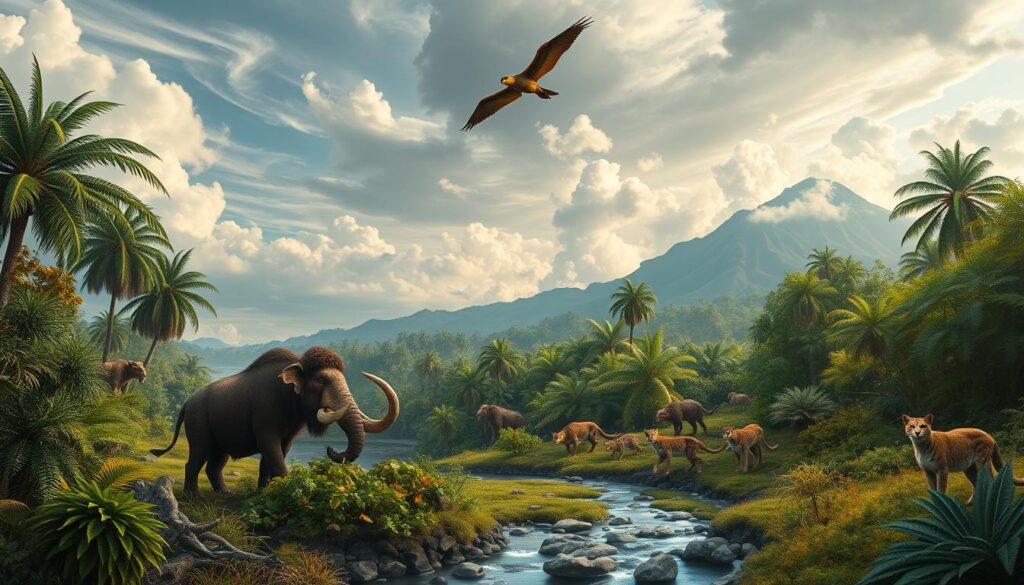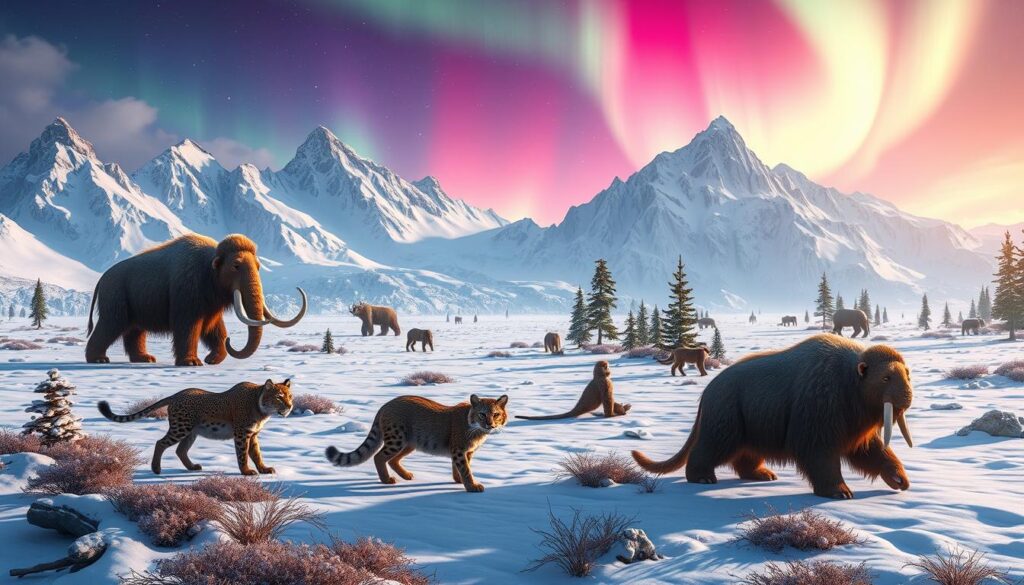Imagine a time when huge creatures filled Earth. These giants were even bigger than today’s biggest animals. 65 million years ago, these amazing prehistoric animals roamed our planet. They changed life as we know it.
From the huge dinosaurs that walked the land to the scary sea reptiles, the ancient world was full of wonder. It showed us nature’s incredible power and variety.

We’re going to explore the world of Earth’s ancient creatures. We’ll learn about their amazing ways, how they evolved, and how they changed our world. Get ready to see the grandeur of these long-lost giants that once ruled our planet.
Key Takeaways
- Prehistoric animals ruled the Earth millions of years ago, before the dawn of modern human civilization.
- These ancient creatures, from towering dinosaurs to massive marine reptiles, exemplified the incredible diversity and adaptability of life on our planet.
- Studying the prehistoric world provides invaluable insights into the evolution of life, the shaping of ecosystems, and the dramatic changes our planet has undergone over time.
- Understanding the rise and fall of these prehistoric giants can help us better comprehend the delicate balance of our own modern-day ecosystems and the importance of environmental conservation.
- The fascination with these long-extinct life forms continues to captivate the public imagination, fueling ongoing research and exploration into the mysteries of the ancient world.
The Dawn of Prehistoric Animals: Understanding Earth’s Ancient Inhabitants
The prehistoric era was a time when Earth was very different. It’s filled with ancient life’s leftovers. From simple cells to complex animals, Earth’s past is a story of wonder.
Defining the Prehistoric Era
The prehistoric era started when Earth formed, about 4.6 billion years ago. It ended with the start of written records, around 5,000 years ago. This long time is split into eras, each with its own changes and life forms.
Methods of Studying Ancient Life
- Paleontology: Looks at fossils to learn about ancient life’s structure and evolution.
- Radiometric Dating: Figures out rock and fossil ages by studying radioactive decay.
- Comparative Anatomy: Compares modern and ancient species’ bodies to understand evolution.
Timeline of Prehistoric Animal Evolution
- Precambrian Era (4.6 billion to 541 million years ago): First single-celled life started here.
- Paleozoic Era (541 million to 252 million years ago): Complex invertebrates and first vertebrates appeared.
- Mesozoic Era (252 million to 66 million years ago): Dinosaurs like T. rex and Brachiosaurus emerged.
- Cenozoic Era (66 million years ago to present): Mammals, including Ice Age giants, and humans evolved.
Exploring the prehistoric era is a journey that amazes scientists and the public. By studying fossils and using other methods, we learn about Earth’s past. This helps us appreciate the amazing diversity of life on our planet.

Most Fearsome Predators of the Prehistoric World
The prehistoric world was filled with fierce predators. Tyrannosaurus rex, Spinosaurus, and Megalodon were at the top. They ruled their worlds and changed their prey.
Tyrannosaurus rex was a giant dinosaur from the Late Cretaceous period. It had a big head, strong jaws, and sharp teeth. It could eat huge plants like Triceratops.
Spinosaurus was different. It had a long body and a sail on its back. It lived in water and ate fish and other sea creatures. It was even bigger than Tyrannosaurus rex.
Megalodon was a huge shark from the Miocene and Pliocene epochs. It could grow up to 60 feet long. It ate whales and sea lions with its strong jaws.
These prehistoric predators were not just scary. They changed their worlds. Their hunting ways helped their prey evolve, making life rich and diverse.
| Prehistoric Predator | Physical Characteristics | Hunting Strategies | Ecological Role |
|---|---|---|---|
| Tyrannosaurus rex | Massive head, powerful jaws, serrated teeth | Capable of taking down large herbivores | Apex predator of the Late Cretaceous period |
| Spinosaurus | Sail-backed, crocodile-like jaws, specialized teeth | Adapted to a semi-aquatic lifestyle, preying on fish and other aquatic creatures | Largest known prehistoric predator |
| Megalodon | Colossal size, up to 60 feet in length, massive jaws and serrated teeth | Capable of preying on even the largest marine mammals | Apex predator of the ancient oceans |

Giants of the Ice Age: Megafauna Mammals
The Pleistocene epoch, also known as the Ice Age, was a time of great wonder. It was when the biggest prehistoric animals lived. These were the megafauna mammals, huge creatures that filled the land.
The Rise of Woolly Mammoths
The woolly mammoth was a relative of today’s elephants. It had a thick coat and big tusks. These animals lived in the cold, where they helped shape the land and fed early humans.
Saber-Tooth Tigers: Ancient Big Cats
The saber-tooth tiger was a well-known creature. It had long teeth and was a strong hunter. It could catch big prey, like the woolly mammoth, thanks to its powerful jaws and claws.
Giant Ground Sloths
The giant ground sloth was also a part of the Ice Age. It was huge, up to 6 meters tall. These slow animals helped shape the plants around them.
The giants of the Ice Age, like the mammoth, saber-tooth tiger, and giant ground sloth, are amazing. They show us what life was like a long time ago. Their unique features and roles in the ecosystem are fascinating to learn about.

Prehistoric Marine Creatures That Dominated Ancient Oceans
The ancient oceans were full of life. Creatures like Mosasaurus, Plesiosaurs, and Ichthyosaurs ruled the seas. They were the top predators and changed the oceans forever.
Mosasaurus was a huge reptile that lived in the late Cretaceous period. It had strong jaws and sharp teeth. It could eat fish and other sea creatures. Mosasaurus could grow up to 50 feet long.
Plesiosaurs were long-necked, paddle-limbed reptiles. They were good at swimming. They helped keep the ocean’s food chain balanced by eating smaller animals.
Ichthyosaurs looked like dolphins but were reptiles. They were fast and could swim well. They ate fish, squid, and even other Ichthyosaurs.
| Prehistoric Marine Creature | Characteristics | Ecological Role |
|---|---|---|
| Mosasaurus | Massive, predatory marine reptile with powerful jaws and sharp teeth | Top predator in late Cretaceous oceans, hunting a variety of marine animals |
| Plesiosaurs | Long-necked, paddle-limbed marine reptiles with streamlined bodies | Crucial part of the marine food chain, preying on smaller marine animals |
| Ichthyosaurs | Dolphin-like reptiles with streamlined bodies and paddle-like limbs | Apex predators in prehistoric oceans, feeding on a wide range of marine life |
These ancient sea creatures were key to the oceans’ ecosystems. Their fossils teach us about prehistoric marine life and ancient sea creatures that once ruled the oceans.

Flying Reptiles: Masters of Prehistoric Skies
High above ancient lands, pterosaurs ruled the skies. These flying reptiles, like the famous pterodactyl, flew for millions of years. They had amazing adaptations for flying.
Pterodactyl Species and Characteristics
The pterodactyl family had many kinds of flying reptiles. Some had wings as wide as 10 feet. Their wings were like a big membrane, not feathers.
They had sharp teeth and strong jaws. Their eyes were very sharp. This helped them catch food from the air.
Quetzalcoatlus: The Largest Flying Animal
The Quetzalcoatlus was the biggest flying animal ever. It had a wingspan of up to 36 feet. It was huge and could fly over ancient lands easily.
It hunted fish, small mammals, and even other pterosaurs. It was a true giant in the skies.
Adaptation and Extinction Patterns
Flying reptiles were very good at flying. They had special features for millions of years. But, they all died out eventually.
They died because of climate change, losing their homes, and new predators. Learning about their lives helps us understand ancient worlds.
Evolution and Adaptation of Prehistoric Animals
The prehistoric world was always changing. Ancient species could adapt to their environments. They developed special traits to thrive in different places.
Natural selection was key in their evolution. When the environment changed, some animals were better suited. They survived and had more babies, passing on their good traits.
These changes over time led to a wide variety of life. From the huge woolly mammoth to the fast saber-tooth tiger, they all had special adaptations. They used their environment to their advantage, like strong jaws or special senses.
Conclusion:
Prehistoric animals shaped Earth’s ecosystems with awe-inspiring diversity and adaptability. Understanding their evolution, survival, and extinction reveals crucial lessons about nature’s balance, fostering a deeper appreciation of life’s incredible journey through time.

